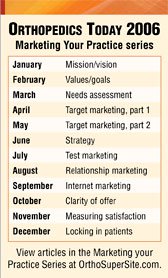‘Lock in’ patients with improved service, access and better quality contact time
Develop long-term advocates who will revisit and rave about your orthopedic practice for years.
 Orthopedic practices can thrive in today’s changing health care environment by locking in current patients.
Orthopedic practices can thrive in today’s changing health care environment by locking in current patients.
That means taking careful steps to ensure existing patients return to your practice, a strategy more critical than ever as patients in today’s managed care and consumer-driven health plans exercise more control over physician choice.
“Raise the barrier to exit,” is how Eric N. Berkowitz, PhD, put it at a recent conference, urging surgeons to make it difficult for patients to migrate elsewhere. How? Meet and exceed patient needs and expectations, he said. Doing that well produces patient advocates for your orthopedic practice, and everyone agrees that the best patient is a satisfied one.
Patient is king
Underscoring the importance of locking in patients, Berkowitz cited these customer behavior statistics:
- The average business never hears from 96% of its unhappy customers;
- Ninety-five percent of the customers with resolved complaints will do business with the company again;
- The average customer who has problems tells nine to 10 other people; and,
- Customers whose complaints get resolved will tell five people.
Building strong relationships with current patients, known as relationship marketing, is easier and more cost-effective than finding new patients, Berkowitz said. Work with the patients you currently have. For example, quickly resolve issues like long wait times in the reception area or offering too little face time with the doctor for patients to feel they received adequate answers for all questions.

Next: Leverage those relationships. The practice already knows a lot about current patients. “They’ve already made a conscious decision to see you,” Bill Champion, president of the Orthopaedic Marketing Group in Omaha, Neb., told Orthopedics Today.
“Create advocates and practice ambassadors that go back out into the market and reinforce that exceptional ‘brand’ is the place to go.”
Relationship building
Locking in patients should naturally result from executing a well-thought-out marketing strategy, he said. Try incorporating aspects of patient-centered care into the four pillars of your marketing plan: mission, vision, core values and goals (see our earlier stories at OrthoSuperSite.com).
By building a strong service culture into your vision, for example, you will constantly deliver every service patients expect, and then some. Experts contend that if such a plan is executed well, then patients will be locked into your practice for good.
The biggest pitfall, according to Berkowitz is that medical practices often fail to integrate patient needs into their plans. A good example of how to do it right: If 20% of your patients are golfers, send them an email in early spring about warm-up tips to get their joints ready for the season ahead. The patient’s need: Play golf without aches and pains. The strategy: Keep its name in front of patients.
Accentuate the positives
He urged practices to spend most of their time and money “strategizing on locking in the good patient base they have.”
Once the patient/practice relationship is solidified “reinforce and entrench certain key messages for patients to tell other people that are both persuasive and compelling,” Champion said. For example, if high school football is big in your town, potential patients of all ages will likely be impressed to hear a doctor at your practice is the team physician. Too often patients walk in and out of a practice’s offices and never know that kind of information.
Find quick ways to communicate such messages effectively to current patients.
If the practice partners are unsure whether or not their efforts at building better patient relationships are working, Champion suggested asking patients bi-annually whether they would highly recommend the practice to friends and family “It’s either a yes or a no answer.”
Satisfied patients and practice advocates can evolve into a significant source of referrals so continually stay in touch with them. Try sending them educational material and communicating key messages via mail or email well after their last follow-up visit to keep them locked into your practice.
|
For more information:
- Berkowitz EN. Strategic positioning and marketing ICL#328. Presented at the American Academy of Orthopaedic Surgeons 72nd Annual Meeting. Feb. 23-27, 2005. Washington.
- Eric N. Berkowitz, PhD, is associate dean for professional programs at Isenberg School of Management at the University of Massachusetts Amherst, 121 Presidents Drive, Amherst, MA 01003. He can be contacted at enb@mktg.umass.edu or http://www.isenberg.umass.edu/marketing/Faculty/Profiles/Eric_Berkowitz/.
- Bill Champion is president of Orthopaedic Marketing Group, 3227 Harney St., Omaha, NE 68131. He can be contacted at 402-490-4560, or bchampion@orthopaedicmarketing.com.
- View articles in the Marketing your Practice Series at OrthoSuperSite.com.
